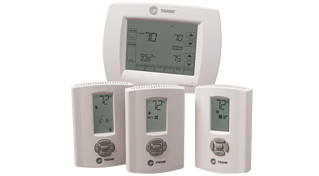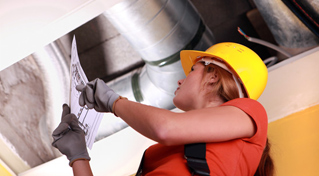Sprinkler System Maintenance
Update Your Sprinkler System’s Controller
Billions of gallons of water are wasted every day from inefficient landscape watering. Newer, more efficient irrigation-control technologies use local weather and landscape conditions to tailor watering schedules to the conditions in your yard. For example, a rain and freeze sensor automatically shuts off your irrigation system during rain or freezing temperatures. This landscape irrigation guide has additional information on watering efficiently.
Want more landscaping ideas? Click here for more great information about environmentally friendly yard care.
Setting Your Irrigation System for Optimum Efficiency
Water .75 to 1.0 inches every time you water, watering until soil is moist at least 4? deep in flowerbeds and deeper below turf. (One hour or more after watering, dig down with a screwdriver or other tool to check.) This will take several watering cycles with 45 minutes to an hour between each cycle to avoid losing water to runoff.
To set your timer:
- In each zone, run your sprinkler system until you begin to see runoff, then immediately turn off the water. This will tell you how long a cycle you can run in that zone without wasting water.
- Place tuna or cake pans between sprinklers for a period of time in each zone to learn how long it will take to get one inch of water. Be sure to run in cycles to avoid runoff!
- Water a total of .75 to 1.0? water once per week in short cycles are needed in that zone. Leave 45 minutes to an hour between cycles to give time for water to be absorbed.
- Extend time between watering as long as possible to allow time for roots to stretch deeper for moisture.
Signs of moisture stress:
Plants wilted in the morning; turf turning off color with dull purplish cast, leaf rolling or slight browning off, footprint tracks left when walked on. If you see these symptoms in just a few spots, water those few spots with a hose. As other parts dry down, then water the zone.
When more frequent watering might be needed:
If you have shallow soil, you may have to water more often in turf areas until you are able to build soil depth by using top dressing spring and fall.
In mid-summer extreme heat, there may be such high evapo-transpiration that you must water twice a week depending on your choice of plants and how successful you have been watering infrequently to develop deeper roots on your turf.
Notes: Shrubs and trees should be deeply soaked every three to four weeks during the dry season.
Trees: with pencil-sized stream, water area midway truck to drip-line and a little beyond. Divide into areas like face of clock, two hours or more each area. Keep moving around. Check moisture depth.
Check your watering system monthly. Be sure someone has access for your watering system when you are away from an extended time to adjust as necessary.
Need Help?
For assistance in programming your irrigation controller, call Customer Care at (512) 930-3640, or email customercare@georgetown.org.
How HVAC Control Systems Help
A great way to improve the efficiency of heating and cooling systems is to incorporate control strategies that ensure systems are used only when necessary. Common control strategies include ENERGY STAR qualified programmable thermostats, multiple zones, and CO2 demand sensors. These strategies can be specified on new heating and cooling systems and retrofitted to older systems as well.
- ENERGY STAR Qualified Programmable Thermostats: These simple, easy to install thermostats allow convenient night/weekend setback to save you money. Models range from $50 to $200 depending on the desired features and usually include manual overrides to ensure comfort for late night workers.
- Multiple Zones: By dividing your facility up into multiple heating and cooling zones, your system can deliver more efficient heating and cooling by eliminating inaccuracies from a central sensor point. In addition, building occupants in different areas can adjust the temperature to meet their actual needs. If your facility has many rooms or floors, multiple zones are recommended.
- Demand or CO2 Sensors: Most heating and cooling systems draw in ventilation air by assumed occupancy, however modern technology has side-stepped this by designing systems that actually can regulate the air quality of your facility by measuring the amount of CO2 present. The result is more energy-efficient operation and better air-quality.
What to do to Maintain Your HVAC
Just like your automobile, your facility’s heating and cooling systems need maintenance to operate efficiently. To improve efficiency and help ensure reliability and long life, consider the following tips.
- Engage a qualified HVAC firm in a maintenance contract with seasonal tune-ups. During these tune-ups, a technician should check combustion efficiency, refrigerant charge, and belt tension as applicable. Check NextDoor, the BBB website, Yelp, and other websites to find a good technician.
- Replace air filters regularly. Accumulated dirt and dust make your fans work harder. Clean or replace filters as recommended by your system’s manufacturer.
- Clean the evaporator and condenser coils on your heat pump, air-conditioner, or chiller. Dirty coils inhibit heat transfer; by keeping them clean, you save energy. Instructions for how to clean the coils should be available on the manufacturer’s website.
- Inspect ducts and piping for leakage or damaged insulation. Leaky ductwork is one of the biggest contributors to cooling loss in buildings. Apply duct sealer, tape, and insulation as needed. There are a number of how to videos and articles on how to find those leaks in your AC duct work.
Solar Panels and Backup (Battery) Generation
Did you know that the City of Georgetown Texas has a solar panel and backup generation program? This program is designed for residential and small commercial customers. If you would like to find out more, visit our Distributed Generation here.
TIP – Take It Outside
After washing your clothes, save energy by hanging them outside to dry!
Clothes dryers are among the biggest energy hogs in a typical household.
Air drying your washed clothes, instead of putting them in your loud, energy sucking, house-heating electric dryer is a great way to save energy … and it is making a comeback.
People talk about recovering the lost art of line-drying clothes idea the way our grandparents did it, but the ease and efficiency of modern technology is enticing. It may help to consider the other advantages of line-drying:
- You don’t have to hang around the house to pull out the clothes and fold them before they wrinkle (or set the timer for 4 hours of tumble). After drying, line dried clothes are ready anytime.
- Clothes last longer because they don’t get overheated, which can lead to the shrinking of some things (pants) and the stretching out of others (anything with elastic.)
- Rather than using detergents, whose chemical scents most often fall short of the fresh air they are trying to simulate, with line-dried clothes, you have the real thing!
Air drying your wash uses no electricity, and can be as easy as hanging a cord between two trees or as complicated as installing the big, spinning, pole-mounted one that looks like a huge TV antenna.
Of course, line-drying your clothes may cut down on the electric energy you use, but what about the extra energy needed from you?
The secret is to handle each piece of clothing as little as possible. One way this can be done is by hanging your clothes on plastic hangers, right out of the washer, while they are still wet and hanging the hangers on the clothesline…even those pieces that don’t usually hang on coat hangers, like your leotards and superhero capes. Smaller items, like socks and underwear can be placed on a drying rack. This aids in drying and keeping the wrinkles out, as well as avoiding the little indention’s that the clothes pins can leave in some of the clothes.
Once the clothes are dry, you just grab the hanging clothes and move them to a closet.
Penalty Waiver Application
A customer who is disabled, or who is 60 years of age or older, may request, in writing, a standing waiver of the late penalty, for utility payments made after the due date.
The customer’s disabled status must be verified by an Award Letter from the Social Security Administration. This waiver applies only to the account holder or their spouse.
Utility Customer Confidentiality
On June 18, 2021, Governor Greg Abbott signed HB 872 and declared it effective immediately. What does this mean for City of Georgetown utility customers? Prior to HB 872, if a customer wanted their account information to remain private, the customer would have to fill out a Confidentiality Request form.
With the passage of HB 872, all customer information of municipally-owned utilities is completely private* and may not be shared without customer permission. To learn more about HB 872, visit https://capitol.texas.gov/BillLookup/History.aspx?LegSess=87R&Bill=HB872
If you would like your customer information to be accessible (not private) to outside entities, please fill out the Request to Disclose form located here.
* Confidentiality under Chapter 182 does not prohibit a government-operated utility from disclosing personal information in a customer’s account record to: (1) an official or employee of the state, a political subdivision of the state, or the United States acting in an official capacity; (2) an employee of a utility acting in connection with the employee’s duties; (3) a consumer reporting agency; (4) a contractor or subcontractor approved by and providing services to the utility, the state, a political subdivision of the state, or the United States; (5) a person for whom the customer has contractually waived confidentiality for personal information; or (6) another entity that provides water, wastewater, sewer, gas, garbage, electricity, or drainage service for compensation.
Aqua Alerts
With the AquaMessenger program, you decide what levels of water use in your home would trigger an email to you. For instance, if you wish to be emailed after you have used 10,000 gallons of water in a single billing month, set the first alert level to 10,000. Once you use 10,000 gallons, you will receive an email alert letting you know.
To sign up, visit https://records.georgetown.org/Forms/Aqua-Alerts
Water Conservation Plan
This Water Conservation Plan was developed to maintain and extend the available water supply to the City’s certified service area and to protect the integrity of water supply facilities
with a focus on domestic water use, sanitation and fire prevention; to protect and preserve public health, welfare and safety; and to minimize the adverse impacts of water supply shortages or other water supply emergency conditions. This comprehensive plan includes the adoption and implementation of recognized water conservation best management practices.
Click here to read the full Water Conservation Plan.













